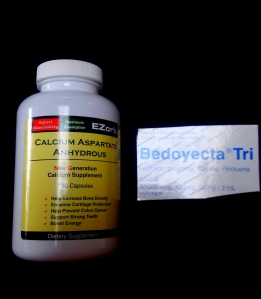
Dr Aceves – Ajijic, Jalisco, MX
For the women out there who have had a complete hysterectomy, this post is for you. At the age of 23 I had a total hysterectomy and prior to moving to Mexico at the age of 62, my life operated on the supernatural strength given to me by God. My husband can testify to the vast improvement after each hormone implant I have received. When the female body hormone manufacturing plant is taken out, it is imperative that you request that your doctor examine your regular blood panel closely. Life gets busy and I was due for my next hormone pellet implant in March, however, I went on a Caribbean Cruise and you would think that a vacation would increase my energy and enthusiasm. I came home exhausted and for the past few months I felt like I was flat lining. To take a shower and get dressed was a huge effort. Thinking that I was simply depressed, I went to the doctor and he prescribed a complete blood panel. A blood panel to include the following important items: TSH hormone, T4 libre, T3 libre, Testosterone libre, Estrogen, Progesterone, and cortisol. The results were emailed to my regular MD and Dr Juan Aceves, a microbiologist who specializes in hormone replacement therapy. Annual check-ups for women who have had a hysterectomy, be forewarned….most doctors never look at cortisol, adrenals and hormone levels. We castrated women suffer from night sweats, insomnia,  hair loss, muscle loss, bone loss, incontinence, mood swings, and memory loss. Also when a woman is low in testosterone it could be the cause of her inability to lose weight and loss of bone mass! To increase bone density, by taking EZORB calcium, my bones actually grew stronger. Bioavailability is important in calcium. Clinical studies of EZORB http://www.elixirindustry.com/ClinicalStudy.htm With Ezorb calcium, “B” shots, and a hormone pellet implant, a woman must continue to rely on the strength God gives us. PATIENCE is the key. Don’t expect immediate improvement. IMPORTANT: your full blood panel to include the following items: TSH hormone, T4 libre, T3 libre, Testosterone libre, Estrogen, Progesterone, and cortisol. Do your own research on the importance of adrenals and hormones then discuss your results with a doctor who specializes in the bodies endocrine system.
hair loss, muscle loss, bone loss, incontinence, mood swings, and memory loss. Also when a woman is low in testosterone it could be the cause of her inability to lose weight and loss of bone mass! To increase bone density, by taking EZORB calcium, my bones actually grew stronger. Bioavailability is important in calcium. Clinical studies of EZORB http://www.elixirindustry.com/ClinicalStudy.htm With Ezorb calcium, “B” shots, and a hormone pellet implant, a woman must continue to rely on the strength God gives us. PATIENCE is the key. Don’t expect immediate improvement. IMPORTANT: your full blood panel to include the following items: TSH hormone, T4 libre, T3 libre, Testosterone libre, Estrogen, Progesterone, and cortisol. Do your own research on the importance of adrenals and hormones then discuss your results with a doctor who specializes in the bodies endocrine system.  I get all natural customized hormone implants each quarter in Mexico. The procedure takes about 10 minutes in his office. Five of my friends in Mexico have also raved about the improvement of their sleep and their moods. The use of this hormone replacement therapy has been around since the late 1930’s. For years I used oral hormone pills, and also the patch, however, because cancer runs in my family I stopped all forms. The cost for a customized hormone pellet is 5,000 pesos which is about $275.00 USD. Ladies in menopause or women with hysterectomy, IT IS WORTH every cent to request a special blood panel with the items above checked. CLICK into his website: Dr Juan Aceves
I get all natural customized hormone implants each quarter in Mexico. The procedure takes about 10 minutes in his office. Five of my friends in Mexico have also raved about the improvement of their sleep and their moods. The use of this hormone replacement therapy has been around since the late 1930’s. For years I used oral hormone pills, and also the patch, however, because cancer runs in my family I stopped all forms. The cost for a customized hormone pellet is 5,000 pesos which is about $275.00 USD. Ladies in menopause or women with hysterectomy, IT IS WORTH every cent to request a special blood panel with the items above checked. CLICK into his website: Dr Juan Aceves



I haven’t had a hysterectomy but had ovarian failure at a young age. I haven’t been able to get my hormones in check so appreciate some of your insight. Thank you!
LikeLiked by 1 person
A hormone is any member of a class of signaling molecules produced by glands in multicellular organisms that are transported by the circulatory system to target distant organs to regulate physiology and behavior.
Hormones are special chemical messengers in the body that are created in the endocrine glands. These messengers control most major bodily functions, from simple basic needs like hunger to complex systems like reproduction, and even the emotions and mood. Understanding the major hormone functions will help patients take control of their health. -the group discussed the major hormones and some of the Glands that produce them.
AND SUPRISE – Vitamin D!
Getting some sun to “soak up some Vitamin D” is something you probably hear regularly during warmer months. However, the truth is, this often-misunderstood “vitamin” is not a vitamin — it is a hormone. In fact, unlike other vitamins, only about 10 percent of the vitamin D the body needs comes from food, and the rest the body makes for itself.
read all about it – http://www.hormone.org/hormones-and-health/what-do-hormones-do
10 Ways to Balance Hormones Naturally – COPY and PASTE and READ
https://draxe.com/10-ways-balance-hormones-naturally/
POSTMENOPAUSAL
Hormones both cause the symptoms associated with post menopause and can help alleviate them, since the levels of hormones is key. In this section, you will find information about both natural and synthetic hormones, as well as their benefits and risks. A decrease in estrogen levels is often the cause of post menopause symptoms. There are, however, a few ways to reintroduce estrogen naturally.
A lower level of estrogen, postmenopausal women are at increased risk for a number of health conditions, such as osteoporosis and heart disease. Progesterone works with estrogen to ensure that women are able to conceive and carry a child to term. During post menopause, progesterone levels drop to almost zero.
To avoid uncomfortable post menopause symptoms, progesterone and estrogen should be balanced. Too much of one or the other might cause symptoms to worsen.
In postmenopausal women, testosterone production does not decrease as much as estrogen and progesterone production does. This can cause testosterone levels to be higher relative to the female sex hormones, sometimes leading postmenopausal women to have deeper voices or more noticeable facial hair.
LikeLike
Our Lighten Up topic was The GLANDS (Endocrine) and the 4 BODY TYPES (Dr Eric Berg)
-we focused on the Adrenal and Thyroid.
Endocrine Glands are glands of the endocrine system that secrete their products, hormones, directly into the blood rather than through a duct. The major glands of the endocrine system include the pineal gland, pituitary gland, pancreas, ovaries, testes, thyroid gland, parathyroid gland, hypothalamus and adrenal glands.
Medical Images http://anatomy-medicine.com/endocrine-system/
ADRENAL – Suprarenal glands
The human body has two adrenal glands and one sits on top of each kidney. Each adrenal gland weighs 4-5 g in an adult.
Each adrenal gland is composed of two distinct parts: the outer part called the adrenal cortex and the inner adrenal medulla. The adrenal glands secrete different hormones which act as ‘chemical messengers’. These hormones travel in the bloodstream and act on various body tissues to enable them to function correctly. All adrenocortical hormones are steroid compounds derived from cholesterol. The adrenal cortex produces three hormones: Mineralocorticoids: the most important of which is aldosterone. This hormone helps to maintain the body’s salt and water levels which, in turn, regulates blood pressure. Without aldosterone, the kidney loses excessive amounts of salt (sodium) and, consequently, water, leading to severe dehydration.
Glucocorticoids: predominantly cortisol. This hormone is involved in the stress response and also helps to regulate body metabolism. Cortisol stimulates glucose production by mobilizing amino acids and free fatty acids. Cortisol also has significant anti-inflammatory effects.
Adrenal androgens: male sex hormones mainly dehydroepiandrosterone (DHEA) and testosterone. All have weak effects, but play a role in early development of the male sex organs in childhood, and in women during puberty. These are involved in creating and maintaining the differences between men and women.
Adrenocorticotropic hormone (ACTH) secreted by the anterior pituitary primarily affects release of glucocorticoids and adrenal androgens by the adrenal and to a lesser extent, also stimulates aldosterone release. The adrenal medulla produces catecholamines: Catecholamines include adrenaline, noradrenaline and small amounts of dopamine – these hormones are responsible for all the physiological characteristics of the stress response, the so called ‘fight or flight’ response. What could go wrong with my adrenal glands?
Please read for further information – http://www.yourhormones.info/glands/adrenal_glands.aspx
THYROID –
The thyroid gland is a butterfly-shaped organ located in the base of your neck. It releases hormones that control metabolism—the way your body uses energy. The thyroid’s hormones regulate vital body functions, including:
Breathing
Heart rate
Central and peripheral nervous systems
Body weight
Muscle strength
Menstrual cycles
Body temperature
Cholesterol levels
Much more!
The thyroid is part of the endocrine system, which is made up of glands that produce, store, and release hormones into the bloodstream so the hormones can reach the body’s cells. The thyroid gland uses iodine from the foods you eat to make two main hormones:
Triiodothyronine (T3)
Thyroxine (T4)
It is important that T3 and T4 levels are neither too high nor too low. Two glands in the brain—the hypothalamus and the pituitary communicate to maintain T3 and T4 balance.
The hypothalamus produces TSH Releasing Hormone (TRH) that signals the pituitary to tell the thyroid gland to produce more or less of T3 and T4 by either increasing or decreasing the release of a hormone called thyroid stimulating hormone (TSH).
When T3 and T4 levels are low in the blood, the pituitary gland releases more TSH to tell the thyroid gland to produce more thyroid hormones.
If T3 and T4 levels are high, the pituitary gland releases less TSH to the thyroid gland to slow production of these hormones.
Why You Need a Thyroid Gland
T3 and T4 travel in your bloodstream to reach almost every cell in the body. The hormones regulate the speed with which the cells/metabolism work. For example, T3 and T4 regulate your heart rate and how fast your intestines process food. So if T3 and T4 levels are low, your heart rate may be slower than normal, and you may have constipation/weight gain. If T3 and T4 levels are high, you may have a rapid heart rate and diarrhea/weight loss.
Listed below are other symptoms of too much T3 and T4 in your body (hyperthyroidism):
Anxiety
Irritability or moodiness
Nervousness, hyperactivity
Sweating or sensitivity to high temperatures
Hand trembling (shaking)
Hair loss
Missed or light menstrual periods
The following is other symptoms of too little T3 and T4 in your body (hypothyroidism):
Trouble sleeping
Tiredness and fatigue
Difficulty concentrating
Dry skin and hair
Depression
Sensitivity to cold temperature
Frequent, heavy periods
Joint and muscle pain
LikeLike
USA glandular purchase without prescription: GLANDULARS
http://www.herbalhealer.com/glandulars.html
“Purest New Zealand Glandular Formulas”
No prescription is necessary.
Orders may be placed online,
by fax 1- 870-269-5424 or mail order to:
HHA Inc.
127 McCain Drive
Mountain View, AR 72560
Purchase online deliver to a friend or hotel near dealer:
Metabolic Complex x1 – Take 2x per day for a month
Endocrine Complex x1 – Take 2x per day for a month
Pure Adrenal 400 x2 – Take 2x per day for 2 months
Pure Thyroid x2 – Take 2x per day for 2 months
Take ‘sequentially’ –
1) complete Metabolic before starting Endocrine
2) complete Endocrine before starting Adrenal / Thyroid.
3) Take both the Adrenal and Thyroid together.
This is a four month process.
The purpose of this protocol is: To lay a foundation to support the Adrenal and Thyroid.
Both Metabolic and Endocrine provide a supportive environment for the Adrenals
Following this protocol will create a better, longer lasting result than by just taking the Adrenal / Thyroid alone.
LikeLike
Pingback: Fascia Facts | Living Abroad
Pingback: KETO EASY FAST | Living Abroad